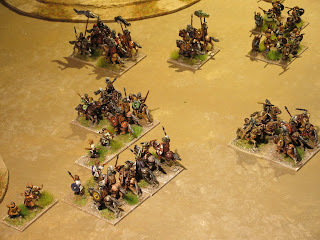In 549 the usurper Athanagild requested assistance of
the East Romans with their rebellion against the Visigothic king . Justinian I did send an army, but after securing Athanagild’s placement on the throne the Byzantine had no intention
of leaving all the cities captured during their campaign. This meant the majority
of the coastal region of southern Hispania remained in East Roman control.
For game purposes, all these actions take place in regions of Iberia and Baetica therefore terrain selection is from the 'arable' or 'hilly' homeland.
For game purposes, all these actions take place in regions of Iberia and Baetica therefore terrain selection is from the 'arable' or 'hilly' homeland.
Game 1
Both armies formed up in the available space between the
difficult hills. The Visigoths deployed in their usual two divisions, infantry on the left and cavalry on the right. The majority of the Byzantine army were
cavalry and these formed the first line with the heavy infantry, light horse and Herul forming a second line.
Moving off at brisk trot, the Visigothic cavalry
advanced toward the Byzantine line while their infantry would secure the hills on both flanks.
The Byzantine demonstrated tactical skill by breaking
up the Visigothic line. In subsequent bounds, the Visigoths lost all semblance
of a cohesive line with individual units becoming vulnerable to flank attacks; this brought the score even (2 – 2).
By this time, the Visigothic infantry had negotiated
the difficult ground on the left to find themselves facing the Byzantine heavy infantry. At
this moment, the Byzantine cavalry counter charged killing their general to bring the battle to an end. Score 4g – 2 for the
Byzantine.
Game 2
The Byzantine were able to secure two gentle hills for
their deployment; placing all their infantry on the left leaving the cavalry
ample room to extend their line to the second hill. The Visigoths deployed in
front of a lake and made use of a hamlet to position their infantry.
The Visigothic cavalry moved forward but kept pace
with their infantry as they advanced. The Byzantine infantry held their current
position leaving the cavalry to start the battle.
The clash of both armies developed into a series of
small combats losing all semblances of well drilled formations. The noble Visigothic
cavalry easily drove back their opposition while Byzantine cavalry contained
the Visigothic gardingi. On both flanks however, the Byzantine suffered severe
casualties.
The decisive stroke came with the death of the Byzantine
general ending the battle. Score 5g – 1
for the Later Visigoths.
Game 3
The final battle found the Visigothic army securing
all the defensible terrain in the area (rough ground and a hamlet) leaving the Byzantine to deploy in an open plain. The Byzantine deployed all their
infantry on the right to seize the rough ground in front leaving the cavalry ample room to deploy in an extended
line.
Precipitating the main assault, the Byzantine left
struck the Visigothic right flank while the army moved at the pace of the
infantry. During the opening phase, the Byzantine psiloi had seized the rough ground as planned.
With the help of the psiloi, the Byzantine heavy infantry
overpowered their opposition to roll up the Visigothic left. In the centre and
left the battle raged to and fro.
With the Visigothic left flank gone and the right collapsing, their general called for a retreat. Score
4 – 0 for the Byzantine.





































